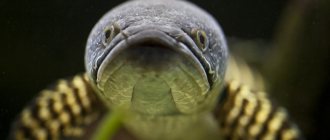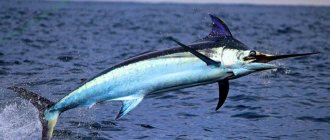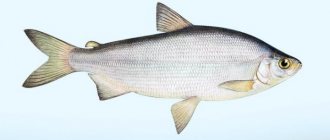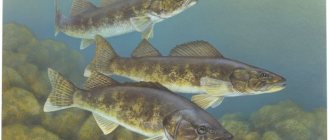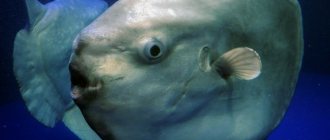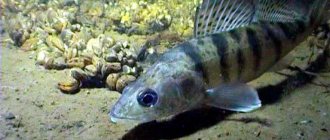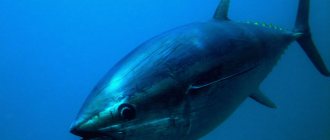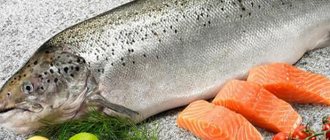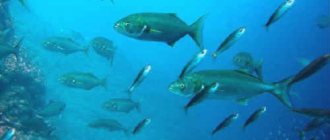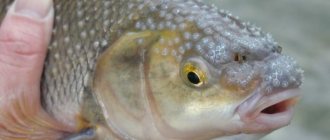Kalamoicht (lat. Erpetoichthys calabaricus) or as it is also called - snake fish, is an extremely unusual-looking, graceful and ancient fish. It is interesting to watch the kalamoikht, it is quite easy to keep, but it is important to remember that it must be kept with medium- and large-sized fish. The snake fish will hunt the rest. Although they are predominantly nocturnal, with regular feeding during the day they become accustomed and become more active during the day.
Habitat in nature
Erpetoichthys calabaricus is a species of freshwater fish in the family Polypteridae. It is the only representative of the genus Erpetoichthys. The genus name comes from the Greek words erpeton (crawling creature) and ichthys (fish).
Kalamoicht calabar lives in western Africa, in the waters of Nigeria and Congo, Angola, Cameroon. Lives in slowly moving or stagnant, brackish or fresh, warm water at a temperature of 22-28 °C.
The fish is nocturnal and feeds on annelids, crustaceans and insects. When moving slowly through the water, it tends to use its pectoral fins, switching to a different form of swimming (more using the movements of the whole body and the caudal fin) when moving quickly. Both in the wild and in captivity, fish are known to explore land if given the opportunity, slithering across it like a snake, as well as hunting on land.
Females repeatedly lay small batches of eggs between the male's anal fins, where they are fertilized. The male reedfish then scatters the eggs among aquatic vegetation, where they adhere to plants and substrate. The larvae hatch quickly (after 70 hours) but remain attached to the vegetation; they become independent and begin to feed after ~22 days, when the yolk sac of the egg has been eaten
In nature, it lives in stagnant or slow-flowing water, with a low oxygen content, to which the species has adapted and can literally stick its head out of the water to breathe atmospheric oxygen. The species is threatened by habitat loss due to palm oil plantations, other agriculture, deforestation and urban development.
The fish has developed lungs, which allow it to even live on land for some time, subject to high air humidity.
Reproduction of kalamoichta
During courtship, the male and female swim in parallel. The female lays several eggs at the base of the anal fin of the male, who fertilizes them. Then the eggs roll into the plant thickets and stick to the substrate. This procedure is repeated several times. The eggs have a diameter of 2.1-2.6 mm. The larvae hatch after 70 hours and remain hanging on the substrate. After 22 days, the yolk sac is completely absorbed, and the fry begin to swim and feed on their own.
Source
Description
The Calabar calamoicht is an ancient creature that can even be called a fossil. In nature they can grow to a maximum total length of 37 cm, in an aquarium it is usually less - about 30 cm long.
The kalamoichta has an elongated body, similar to an eel, without a ventral fin. The long dorsal fin consists of a number of well-divided spines, each of which supports one or more articulated rays. The reed fish has a pair of lungs that allow it to breathe atmospheric air. This allows the species to survive in water with low dissolved oxygen and survive for intermediate periods of time out of water. The larvae have prominent external gills, making them look like salamander larvae
The lifespan of the kalamoichta is up to 8 years.
Description and photo
The snake-like aquarium fish Calamoicht is naturally distributed over a large area of western Africa, covering the territory from Cameroon to Benin. Most often, this type of fish can be found in the Niger Delta.
Kalamoicht has a long snake-like body covered with hard scales. Its average length is 37 cm, and the maximum reaches 90 cm. The fish has no pelvic fins. The elongated muzzle ends with black beady eyes and antennae for touch.
The color of Kalamoichta is greenish with an olive tint. The pectoral fins are fan-shaped, their bases are decorated with large black spots. Females are slightly thicker and have a convex abdomen. The hind fin of males is larger, darker and fan-shaped, while that of females is triangular and small in size.
Thanks to the presence of not only gills, but also lungs, the snake fish has a completely unique ability - to stay out of water for up to eight hours. True, at the same time, her body should remain moderately hydrated.
Important! Another method of sex differences in snake fish: the dorsal fin of the male, most often, has 12–14 rays, and the female has 9–12. But this method is not absolutely reliable.
Keeping in an aquarium
Kalamoikhta should be kept in large aquariums. The fact is that the fish can grow quite large and require a lot of space for swimming.
Adults should be kept in aquariums with a volume of at least 200 liters. Although they are predominantly nocturnal, with regular feeding during the day they become accustomed and become more active during the day.
But at the same time, kalamoichts are rather timid fish, even shy. It is important to create shelters for them in which they can hide during the day and hide in case of persecution.
You also need soft soil, without sharp edges. Fish can burrow into the ground and it is important that they do not damage their scales.
Remember that fish can easily escape from the aquarium, it is important to tightly close all possible cracks. They can get through cracks that seem impossible to crawl through and travel quite long distances on land.
They tolerate neutral or slightly acidic water well, with a pH of 6.5 - 7.5. Water temperature 24-28°C. In nature, Calabar calamoichts are sometimes found in slightly salty water, for example in river deltas.
Because of this, they are believed to love salt water, but unlike other fish species that live in salt water, they do not tolerate high salt levels well. Preferably no more than 1.005.
Compatibility with other fish
Snake fish should not be large in size, but they should not be smaller than their “neighbors.” An excellent company for them are cichlids, catfish or sonodontis.
You also need to know that you shouldn’t add too active fish to them. Otherwise, they will take away all the food from the snake-like creatures. And, conversely, small fish may end up in their stomach. These include tadpoles, small catfish or newts. In addition, snake fish can eat neon as well as zebrafish. As for the kalamoichta, it is capable of eating even its own kind, only smaller in size.
If such fish are kept in communal aquariums, fights over food may even occur. To prevent this from happening, the aquarium must be large and have enough food for everyone. Most often they are settled in 4-5 individuals in one container.
Those who choose to keep such unusual fish should definitely be familiar with all the recommendations for keeping them.
In the next video you can watch the Calabar calamoicht while feeding.
A fish, like a snake crawling among the plants in an aquarium, certainly attracts attention and raises questions about who it really is: a fish or a snake. A long snake-like body, a small flattened head, diamond-shaped scales, inconspicuous dorsal fins often pressed to the back and absent abdominal fins - this is what a fish looks like, but is not a snake. Although all these features of appearance can mislead us into thinking that there is a snake in front of us, in much the same way that a snakehead is sometimes mistaken for a snake because of the shape of its head.
Upon careful examination of the appearance of this aquatic inhabitant, the following become noticeable:
- raised gill covers located on the sides of the head and pectoral fins of a rounded shape, similar to two small fans;
- and in front of the small rounded caudal fin, the anal fin is visible, which also has a neat shape with rounded edges.
It becomes clear that in front of us is a fish called the Calabar calabar (Erpetoichthys calabaricus) and is often called the snake fish. The maximum size to which it can grow is 37 centimeters (this figure is indicated as correct on the fishbase website).
Compatibility
It is important to remember that calamoikhtas will hunt fish that they can swallow. It is necessary to keep it with medium and large fish, for example synodontis, small cichlids (Meeka, black-striped cichlid) or large fish living in the middle layers of water.
They get along with such fish without problems and are peaceful. Neons, barbs, shrimp, small catfish are hunted, so don't be surprised if they disappear.
Behavior and Compatibility
The Calabar kalamoicht is considered one of the most unusual fish, not only in appearance, but also in its habits.
- This is a calm, non-aggressive creature that can easily get along with equally peaceful neighbors. The only condition: the fish should not be too small. Through the millennia, Kalamoicht has not lost the desire to hunt and can eat small fish, at least for sport.
- The kalamoichts actively use their ability to climb into any, even the narrowest, crack. They rarely get stuck anywhere, however, after a global cleaning of the aquarium with rearrangement, it is better to first monitor how the fish feel in the new design. And, of course, a tight lid is a must!
- Calamoichtas love to lie on the aquarium ties. If the snake fish is not visible near the front window, where it spends most of its time, look under the cover. Most likely, she lies there. Or in the shade of aquarium plants, resting from the abundance of light.
- The aquarium dragon fish gets used to the owner, and when he sees him, he shows joy by active movements along the aquarium.
- The greatest activity of kalamoichts occurs at night. But during the day they are also quite active, resting for a short time in the shade near the bottom.
Kalamoikhts get along quite successfully with large peaceful fish: thorns, angelfish, some large cyprinids and other fish of a similar size. Predators are also suitable as neighbors: parrots, severums, tilapias, astronotuses, if they do not hunt for calamoichts.
As for intraspecific proximity, dragon fish are not territorial, so several individuals easily coexist in one aquarium. The kalamoichta can also be successfully kept without relatives.
Feeding
Due to very poor eyesight, the kalamoichta developed an excellent sense of smell. It prefers live foods such as bloodworms, small worms, and earthworms.
You can also give pieces of shrimp, fish fillets, and squid. Predatory, will hunt small fish and snails.
The biggest difficulty in feeding is its slowness. While he is thinking, the rest of the fish are already finishing their food. Due to poor eyesight and the habit of hiding, kalamoichts are the last to find food.
To prevent them from starving, drop the food directly in front of them, or feed them at night, when they are most active. This will give them the opportunity to eat normally, since they lose the usual race with fish.
Life at home
According to the experience of many lovers of aquarium animals, snake fish can easily live at home. You just need to take into account all the requirements for the aquarium, food, etc. In addition, there are a few more recommendations:
- It’s better to keep at least a couple of individuals;
- a small amount of sea salt has a positive effect on their condition;
- Newly acquired Kalamoikhts should be fed in the dark, repeating natural conditions.
Requirements for an aquarium
at least 100 liters is required to keep one fish in an aquarium But these fish feel more comfortable with their relatives, without showing any aggression towards their own kind, so it is better to purchase a 250-liter aquarium. It will allow you to comfortably accommodate three to five individuals.
The fish has some properties of a snake, namely, it manages to squeeze into even the smallest holes. Therefore, the presence of a cover glass or lid is strictly necessary. But you need to provide a small gap for the flow of fresh air.
Did you know? Myctophoid anchovies, fish that live deep underwater, can glow. Special organs located on their body and near the eyes produce enough light to read a book next to them.
What should the water be like?
The aquarium is filled with clean fresh water with a temperature of +23...+28 °C, neutral acidity (pH from 6.5 to 7.5) and hardness in the range of 5 - 19 dGH.
It is necessary to ensure constant good filtration of water in the aquarium with weekly changes of 20 - 30% of the water volume.
Find out what temperature the water should be in the aquarium.
If there is an increased content of nitrites, nitrates or ammonia in the water, then Kalamoicht may begin to move sharply and greedily swallow air from the surface. In this case, you should change the water in the aquarium as quickly as possible.
Decorations, soil, plants
Snake fish will feel more comfortable in an aquarium if live plants with strong roots and hanging leaves, sometimes forming thickets, are planted there. For these purposes, it is good to use Vallisneria, Anubias or Aponogeton.
In addition to its decorative functions, the soil maintains the balance of microflora for underwater life. Find out how to choose the best soil for your aquarium.
In addition, it is worth placing stones and driftwood at the bottom, as well as building small grottoes. This will remind residents of their natural habitat.
Sand or works well as soil . But it requires regular siphoning and removal of all accumulated biological debris.
Plants in an aquarium play an important role in the life of its inhabitants. Read about the top 10 best plants for an aquarium.
Optional equipment
Since in nature Kalamoicht is nocturnal, you should not arrange bright lighting in the aquarium. It's better for it to be diffused.
Due to the presence of lungs and the ability to breathe oxygen from the air, this fish does not need a high oxygen content in the water. Therefore, you can do without an aerator.
Breeding and sexual characteristics of the Calabar calamoikhta
Sexual differences between a male and a female can be noticed if you look closely at them))). The female has a slightly drooping abdomen and the anal fin is much lighter than that of the males. As a rule, it has a yellowish-olive tint. Also, males have from 12 to 14 dorsal fins, while females have from 9 to 12. The Calabar kalamoichta has no other distinctive sexual characteristics.
Without artificial hormonal stimulation, calamoikhtas do not reproduce outside natural conditions. Over many, many years, very few people have been able to achieve concrete success in breeding them. Therefore, little is known about the “caviar-fish” episode. Already grown kalamoikhts are brought directly from the nooks and crannies of their vast homeland.
Interesting things about the snake...
Near the reservoirs of West Africa, where our Calabar calamoikht settled, legends were made about the strange snake fish. And they were always not to the advantage of the fish themselves.
Being a snake fish in Nigeria is the same as being a black cat in Rus'. Kalamaicht was always killed, mistaking him for something other than who he really was. From afar, Kalamoichta, which is of course not surprising, was often mistaken for just a snake. And in those places, sadly, almost all snakes are poisonous and bring a lot of trouble to local residents.
Over time, the kalamoichta was nevertheless separated from the species of snakes. But the next sentence was still not comforting for him. Superstitious residents, having heard enough fairy tales and legends from traders from the river, could not help but notice some similarities between the kalamoicht and the Chinese serpentine dragon, which punished the unfaithful and wicked, was wise, but impatient.
